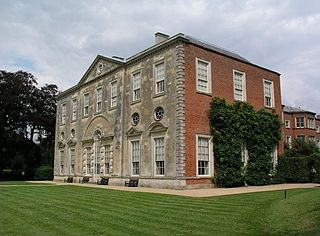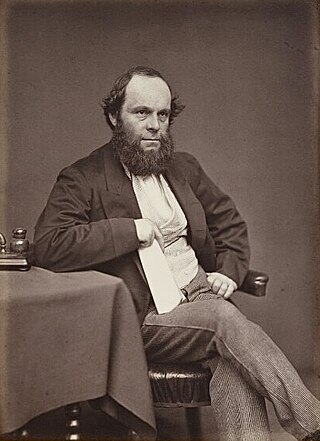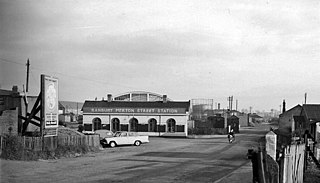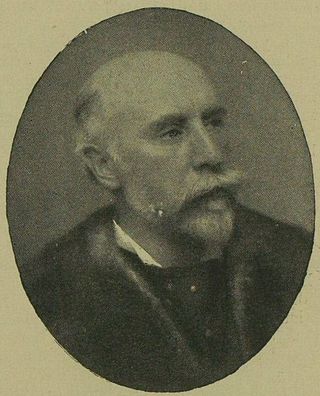
Biddlesden Park is a country house at Biddlesden in north-west Buckinghamshire. It is a Grade II* listed building.

Biddlesden Park is a country house at Biddlesden in north-west Buckinghamshire. It is a Grade II* listed building.
The house, which lies on the site of an old Cistercian abbey, was built by John Sayer, in the Georgian style in 1727. [1] The staircase dates from the same period. [2] The house then passed to Ralph Verney, 2nd Earl Verney before it was acquired, on Verney's death in 1791, by George Morgan, who was High Sheriff of Buckinghamshire. [3] The house remained in the ownership of the Morgan and then the Morgan-Grenville family for most of the 19th century. [4] It was bought by Lieutenant Colonel Reginald Badger in around 1932 and then remained in the Badger family for many years before passing to Mrs. Elizabeth Maud Gordon. [5] It was then comprehensively renovated in the 1980s. [1]
The church of St Margaret of Scotland is situated in the grounds of Biddlesden Park. [6]

Buckingham is a market town in north Buckinghamshire, England, close to the borders of Northamptonshire and Oxfordshire, which had a population of 12,890 at the 2011 Census. The town lies approximately 12 miles (19 km) west of Central Milton Keynes, 19 miles (31 km) south-east of Banbury, and 24 miles (39 km) north-east of Oxford.

George Nugent-Temple-Grenville, 1st Marquess of Buckingham,, known as George Grenville before 1779 and as The Earl Temple between 1779 and 1784, was a British statesman.

Quainton Road railway station was opened in 1868 in under-developed countryside near Quainton, in the English county of Buckinghamshire, 44 miles (71 km) from London. Built by the Aylesbury and Buckingham Railway, it was the result of pressure from the 3rd Duke of Buckingham to route the railway near his home at Wotton House and to open a railway station at the nearest point to it. Serving a relatively underpopulated area, Quainton Road was a crude railway station, described as "extremely primitive".

Stowe is a civil parish and former village about two miles northwest of Buckingham in the unitary authority area of Buckinghamshire, England. The parish includes the hamlets of Boycott, Dadford and Lamport.

Dadford is a hamlet in the parish of Stowe, north Buckinghamshire, England.
Biddlesden is a village and civil parish in Aylesbury Vale district in north-west Buckinghamshire, England on the boundary with Northamptonshire. It is about 5 miles (8 km) east-north-east of Brackley, Northamptonshire and 5 miles (8 km) north-west of Buckingham. The River Great Ouse forms part of the western boundary of the parish, separating the village from Northamptonshire. The ancient royal forest of Whittlewood extended to the northern edge of the village.

Claydon House is a country house in the Aylesbury Vale, Buckinghamshire, England, near the village of Middle Claydon. It was built between 1757 and 1771 and is now owned by the National Trust.

Turweston is a village and civil parish in north-west Buckinghamshire, England. The village is beside the River Great Ouse, which bounds the parish to the north, west and south. Turweston is the most northwesterly parish in Buckinghamshire: the Ouse here forms the county boundary with Northamptonshire to the north and west and Oxfordshire to the south. Across the river, the Northamptonshire market town of Brackley is just west of Turweston, with the town centre about 1 mile (1.6 km) west of the village. The parish has an area of 1,295 acres (524 ha) and had a population of 211 at the 2011 Census.

Richard Plantagenet Campbell Temple-Nugent-Brydges-Chandos-Grenville, 3rd Duke of Buckingham and Chandos,, styled Earl Temple until 1839 and Marquess of Chandos from 1839 to 1861, was a British soldier, politician and administrator of the 19th century. He was a close friend and subordinate of Benjamin Disraeli and served as the secretary of state for the colonies from 1867 to 1868 and governor of Madras from 1875 to 1880.

Richard Plantagenet Temple-Nugent-Brydges-Chandos-Grenville, 2nd Duke of Buckingham and Chandos,, styled Viscount Cobham from birth until 1813, Earl Temple between 1813 and 1822 and Marquess of Chandos between 1822 and 1839, was a British Tory politician. He served as Lord Privy Seal between 1841 and 1842.

Buckingham Rural District was a rural district in the administrative county of Buckinghamshire, England from 1894 to 1974, covering an area in the north-west of the county. It was named after but did not include the borough of Buckingham.
Buckinghamshire is a former United Kingdom Parliamentary constituency. It was a constituency of the House of Commons of the Parliament of England then of the Parliament of Great Britain from 1707 to 1800 and of the Parliament of the United Kingdom from 1801 to 1885.

James Grenville, 1st Baron Glastonbury, PC of Butleigh Court, Somerset was a United Kingdom politician, who was a member of both houses of Parliament during his career.

The Brill Tramway, also known as the Quainton Tramway, Wotton Tramway, Oxford & Aylesbury Tramroad and Metropolitan Railway Brill Branch, was a six-mile (10 km) rail line in the Aylesbury Vale, Buckinghamshire, England. It was privately built in 1871 by the 3rd Duke of Buckingham as a horse tram line to help transport goods between his lands around Wotton House and the national rail network. Lobbying from the nearby village of Brill led to its extension to Brill and conversion to passenger use in early 1872. Two locomotives were bought but trains still travelled at an average speed of 4 miles per hour (6.4 km/h).

Biddlesden was a Cistercian abbey founded in 1147 by Arnold de Bosco, steward to the Earl of Leicester. Abbot William Wibert was deposed in 1198 for fraud, gross immorality and bribery. In the 14th to 15th centuries there was a long running dispute with the parish of Wappenham concerning the collection of tithes. It was never a wealthy house for most of its history and would have been dissolved in 1536 if the monks had not petitioned, and paid, for its continuation. The monastery was finally surrendered in September 1538 and became the possession of Thomas Lord Wriothesley.

Astwell Castle is a manor house in Northamptonshire, England about 1.5 miles (2.4 km) south-west of Wappenham. It is a Grade II listed building and part of the parish of Helmdon, a village 1 mile (1.6 km) west.

Banbury Merton Street was the first railway station to serve the Oxfordshire market town of Banbury in England. It opened in 1850 as the northern terminus of the Buckinghamshire Railway providing connections to Bletchley and Oxford and closing for passengers in 1961 and goods in 1966.

Buckingham was a railway station which served Buckingham, the former county town of Buckinghamshire, England, between 1850 and 1966.

Sir Harry Verney, 2nd Baronet PC, DL, JP was an English soldier and Liberal politician who sat in the House of Commons variously between 1832 and 1885.

Frederick William Verney was a younger son of the long-established Verney family in Buckinghamshire. He became a Church of England clergyman, a barrister, a Siamese diplomat, and a Liberal Party politician, serving as a member of both the Buckinghamshire and London County Councils, and from 1906 to 1910 as the Member of Parliament (MP) for Buckingham.